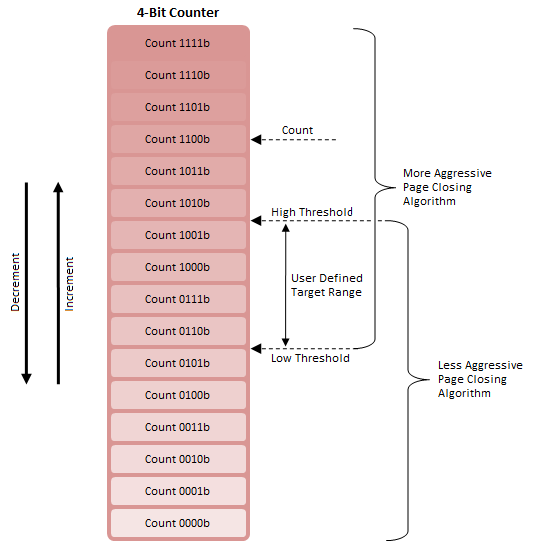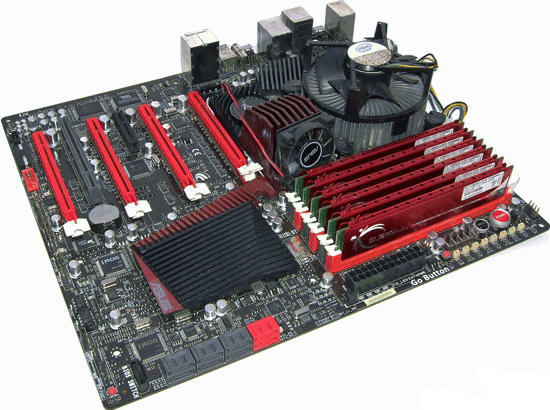标签:
First, consider a 4-bit counter with two adjustable thresholds (Figure 12). When Count is greater than High Threshold, Algorithm A is deemed appropriate; the same is true concerning Algorithm B and Count less than Low Threshold.
For the range between High Threshold and Low Threshold, either algorithm may be in effect. This is because a switch from Algorithm B to Algorithm A will occur only with Count greater than High Threshold and increasing and a switch from Algorithm A to Algorithm B will occur only with Count less than Low Threshold and decreasing.
The overlap range is also the Target Range as the system will naturally attempt to maintain Counter between these two points. This is true since Algorithm A tends to lower Count while Algorithm B tends to raise Count. This system acts to reduce or eliminate rapid thrashing between algorithms.

Figure 12. Another way of looking at this: if the MSB of Count is a 1, then the page close policy is too loose
Next, define a truth table (Figure 13) defining how Count will vary. By doing so we can encode a feedback mechanism into our system. Successful predictions by the Adaptive Page Close Logic - a prevented page-miss access (good) in response to a decision to close a page or a facilitated page-hit access (good) in response to a decision to leave a page open - suggest no change to policy is required and so never modify Count.
For a facilitated page-miss access (bad) due to a poor decision to leave a page open, increment Count. If Count were to trend upward we could conceivably conclude that the current policy was most often wrong and not only that, tended to leave pages open far too long while "fishing" for page-hit operations. The current algorithm must not be closing pages aggressively enough.
For a prevented page-hit access (bad) due to a poor decision to close a page early, decrement Count. If Count were to trend downward we would suspect the opposite: the algorithm is too aggressively closing pages and leaving potential page-hits on the cutting room floor.

Figure 13. The policy is controlling just right whenever we reduce the number of page-miss operations and increase the number of page-hit operations
As best we can tell, this construct represent reality for APM Technology. Although we would like to believe the system has more than two gears (algorithms), our model perfectly explains the existing control register both in type and number.
Looking ahead you will see Max Page Close Limit and Min Page Close Limit are the specified High and Low Threshold values, respectively. Setting a larger difference increases the size of the feedback dead band, slowing the rate at which system responds to its own evaluative efforts. Mistake Counter is represented by the starting Count and should be set somewhere near the middle of the dead band.
Adaptive Timeout Counter sets the assertion time of any decision to keep a page open (i.e. how long before the decision to keep a page open stands before we give up hope of a page-hit access). Repeated access to the same page will reset this counter each time as long as the remaining lifetime is non-zero. Lower values result in a more aggressive page close policy and vice versa for higher values.
Request Rate, we believe, controls how often Count (Mistake Counter) is updated, and therefore how smoothly the system adapts to quickly changing workloads. There must be a good reason not to flippantly set this interrupt rate as low as possible. Perhaps this depletes hardware resources needed for other operations or maybe higher duty cycles disproportionally raises power consumption. Whatever the reason, there‘s more than a fair chance you can hurt performance if you‘re just spit-balling with this setting.
Here at AnandTech we decided to go the extra mile for you, our loyal reader. A few weeks back we approached ASUS USA Tech Support with a request to set-up a technical consultation with their Firmware Engineering Department. After passing along our request, what came out of the meeting was a special beta BIOS that added a number of previously unavailable memory tuning registers once excluded from direct user control.
In the interest of full disclosure, we did request the same help from EVGA and although they were willing to back our play, technical difficulties prevented them from delivering everything we had originally hoped for.
Seen below, these new registers are: Adaptive Page Closing, Adaptive Timeout Counter, Request Counter, Max Page Close Limit, Min Page Close Limit, and Mistake Counter. As suspected, the first setting is used to enabled or disable the feature entirely. Interesting enough, Intel chose not to enable this feature by default; so we leave it up to you.
You won‘t have full resolution when working with these settings, but then again, you won‘t need them anyway
A short description of each register is shown below (taken from Intel Core i7-900 Desktop Processor Extreme Edition Series and Intel Core i7-900 Desktop Processor Series Datasheet, Volume 2, page 79, dated October 2009). Be aware the source most likely contains at least one known error. In particular, Intel has provided exactly the same description for Adaptive Timeout Counter and Mistake Counter. As well, the bit count for Mistake Counter in the table does not match the value in the text, further suggesting someone goofed.

Yep, Intel owes us a correction to Mistake Counter
Once you‘ve had time to fully digest the information above - and ponder how awesome we are - we would like to cordially invite you to do some of your own testing and report your results at our forums. AnandTech readers with a valid login can download ASUS Rampage III Extreme BIOS release 0878 now. We haven‘t really had a chance to do any significant experimenting with what little spare time we have and we need your help exploring uncharted territory...
We hope you’ve enjoyed reading this article as much as we’ve enjoyed putting it together. If you took the time to thoroughly peruse and digest the information within the intricacies of basic memory operation should no longer be such a baffling subject. With the ground work out of the way, we now have a solid platform from which to build as we more closely begin exploring other avenues for increasing memory performance. We’ve already identified additional topics worth discussing, and provided the time shows up on the books, plan to bring you more.
Assumedly, the one big question that may remain: What are the real world benefits of memory tuning? Technically, we covered the subject in-depth last year in a previous article. We suggest you read through it once again for a refresher before you embark on any overclocking journeys (or before you rush out to over-spend on memory kits). Everything written in that article then is just as valid today. We’ve run tests here on our Gulftown samples and found exactly the same behavior. Undoubtably, Intel have taken steps to ensure their architectures aren‘t prematurely bottlenecked by giving the memory controller a big, fat bus for communicating with the DIMMs.

ASUS Rampage III Extreme married to 12GB of sweet, sweet DDR3-goodness
From what we can tell, the next generation of performance processors from Intel are going to move over to a 256-bit wide (quad channel) memory controller, leaving little need for ultra-high frequency memory kits. Thus we re-iterate something many have said before: a top priority when it comes to improving memory ICs and their respective architectures should be to focus development on reducing absolute minimum latency requirements for timings such as CAS and tRCD, rather than chasing raw synthetic bandwidth figures or setting outright frequency records at the expense of unduly high random access times.
Stepping away from the performance segment for a moment, something else that‘s also come to light is rumored news that Intel‘s Sandy Bridge architecture (due Q1 2011) will, by design, limit reference clock driven overclocking on mainstream parts to 5% past stock operating frequency. If this is indeed the case the consequence will be a very restricted ability to control memory bus frequency with limited granularity to tune the first 50~70 MHz past each step, followed by mandatory minimum jump of 200MHz to the next operating level. Accessing hidden potential will be even more difficult, especially for users of mainstream memory kits. While there is no downside to this from a processing perspective (hey, more speed isalways better), this could be another serious nail in the coffin of an already waning overclocking memory industry.
标签:
原文地址:http://www.cnblogs.com/mikewolf2002/p/5179231.html